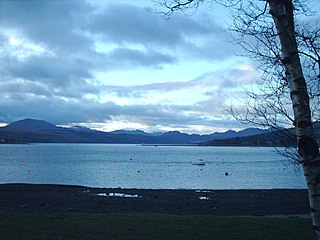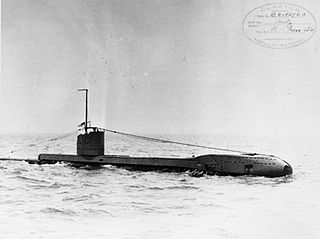
The Royal Navy's Submarine Parachute Assistance Group (SPAG) is a team who provide a rescue support capability to submarine sinking incidents worldwide, available at short notice. [1] [2] [3]

The Royal Navy's Submarine Parachute Assistance Group (SPAG) is a team who provide a rescue support capability to submarine sinking incidents worldwide, available at short notice. [1] [2] [3]
The Submarine Parachute Assistance Group was originally formed from staff of the RN Submarine Escape Training Tank (SETT) at HMS Dolphin in Gosport, Hampshire. The SETT was part of the RN Submarine School, providing wet training in submarine escape drills for both new submariners and those requiring periodic requalification. With the move of the school to HMS Raleigh in Cornwall, in 1999, the SPAG remained at the SETT until the cessation of wet training in 2009. At that point the SPAG was moved to HMS Raleigh.
On 19 November 2017, the SPAG were deployed to HMS Protector in aid of international search efforts for the missing Argentinian submarine San Juan. [4]
The team is made up of instructor personnel from the Royal Navy Submarine School. Members of the group are trained submariners or medical staff posted to the school, subsequently trained in water entry parachute skills. While the SETT was still active, some members of SPAG were trained in diving skills.

The SPAG can be activated at 6 hours notice, to fly to a submarine sinking incident, regardless of the operator of the vessel. The team may work in conjunction with the NATO Submarine Rescue System.
The team is configured to enter the water at the location of the incident, using a static line from the rear ramp of the aircraft. Equipment pods dropped with the team contain Rigid-hulled inflatable boats, life rafts, food, water and medical supplies. This equipment allows the team to establish an afloat reception package for submariners evacuating the sunken vessel, in order to provide medical and life support.
Members of the SPAG are trained in basic parachuting and entitled to wear the Parachute Badge.

The Gare Loch or Gareloch is an open sea loch in Argyll and Bute, Scotland and bears a similar name to the village of Gairloch in the north west Highlands.

HMS Trump was a British submarine of the third group of the T class. She was built by Vickers-Armstrongs, Barrow, and launched on 25 March 1944. So far she has been the only ship of the Royal Navy (RN) to bear the name Trump. She spent the majority of her life attached to the 4th Submarine Squadron based in Australia. She was kept in service following the war and was refitted for greater underwater performance, and was the final RN submarine to be posted in Australia, departing in January 1969. She was sold off and broken up for scrap in August 1971.
There are three major types of submarines in the United States Navy: ballistic missile submarines, attack submarines, and cruise missile submarines. All submarines currently in the U.S. Navy are nuclear-powered. Ballistic missile submarines have a single strategic mission of carrying nuclear submarine-launched ballistic missiles. Attack submarines have several tactical missions, including sinking ships and subs, launching cruise missiles, and gathering intelligence. Cruise missile submarines perform many of the same missions as attack submarines, but with a focus on their ability to carry and launch larger quantities of cruise missiles than typical attack submarines.

HMS Graph was a German Type VIIC U-boat that the British Royal Navy captured during World War II. Commissioned as U-570 in Nazi Germany's Kriegsmarine in mid-1941, she was attacked and captured on her first patrol.

The Royal Navy Submarine Museum at Gosport is a maritime museum tracing the international history of submarine development from the age of Alexander the Great to the present day, and particularly the history of the Royal Navy Submarine Service from the navy's first submarine, Holland 1, to the nuclear-powered Vanguard-class submarines. The museum is located close to the former shore establishment HMS Dolphin, the home of the Royal Navy Submarine Service from 1904 until 1999.

The seventeenth Royal Navy vessel to be named HMS Dolphin was the Royal Naval shore establishment sited at Fort Blockhouse in Gosport. Dolphin was the home of the Royal Navy Submarine Service from 1904 to 1999, and location of the Royal Navy Submarine School.

The Royal Navy Submarine Service is one of the five fighting arms of the Royal Navy. It is sometimes known as the Silent Service, as submarines are generally required to operate undetected.

Submarine Escape Immersion Equipment (SEIE), also known as Submarine Escape and Immersion Equipment, is a whole-body suit and one-man life raft that was first produced in 1952. It was designed by British company RFD Beaufort Limited and allows submariners to escape from a sunken submarine. The suit also provides protection against hypothermia and has replaced the Steinke hood rescue device. The suit allows survivors to escape a disabled submarine at depths down to 600 feet (183 m), with an ascent speed of 2–3 meters/second, at a rate of eight or more sailors per hour.

HMS Unity was a U-class submarine, of the first group of that class constructed for the Royal Navy. The submarine entered service in 1938 and performed war patrols during the Second World War. On 29 April 1940, Unity was accidentally rammed and sunk in Blyth, Northumberland's harbour.

A Submarine Escape Training Tower is a facility used for training submariners in methods of emergency escape from a disabled submarine underwater. It is a deep tank filled with water with at least one underwater entrance at depth simulating an airlock in a submarine. Since the 1930s, towers have been built for use by the Royal Navy, US Navy, Royal Australian Navy and in several other countries.

Captain George Edward Hunt, was a highly decorated Royal Navy submarine commander during the Second World War. While commanding HMS Ultor, he became the British submarine commander with the greatest number of sinkings of enemy vessels to his name, though David Wanklyn achieved sinkings of greater tonnage. Of the 68 torpedoes Hunt fired, 47% hit their targets.
The Royal Navy Submarine School trains non-officer submariners and is located at HMS Raleigh at Torpoint in Cornwall. In 2017 a plan to relocate the school to HMNB Clyde was announced.
The Royal Swedish Navy's Submarine Escape and Rescue system (SMER) is a set of equipment used by the Swedish Navy to provide rescue facilities for the crews of disabled submarines. The submarine rescue ship, the submarine rescue vessel, and the escape system on the submarines, which consists of an escape trunk and an escape suit, are its three main parts.
SPAG or Spag may refer to:
In 1989 the Royal Navy was under the direction of the Navy Department in the UK Ministry of Defence. It had two main commands, CINCFLEET and Naval Home Command.

The following index is provided as an overview of and topical guide to underwater diving:
The Institute of Naval Medicine is the main research centre and training facility of the Royal Navy Medical Service.
The fishing vessel Antares was a pelagic trawler based in Carradale, Kintyre in the United Kingdom. She was fishing off the coast of the Isle of Arran on 22 November 1990 when she foundered with the loss of four crew members after her trawl line was snagged by Royal Navy Trafalgar class nuclear powered submarine HMS Trenchant. An investigation by the Marine Accident Investigation Branch concluded that the accident had been caused by "a partial breakdown in both the structure and the standards of watchkeeping on board Trenchant".
Submarine rescue is the process of locating a sunk submarine with survivors on board, and bringing the survivors to safety. This may be done by recovering the vessel to the surface first, or by transferring the trapped personnel to a rescue bell or deep-submergence rescue vehicle to bring them to the surface. Submarine rescue may be done at pressures between ambient at depth, and sea level atmospheric pressure, depending on the condition of the distressed vessel and the equipment used for the rescue. Self-rescue of submarine personnel by buoyant free ascent at ambient pressure is considered submarine escape. Survivors may require recompression treatment for decompression illness.